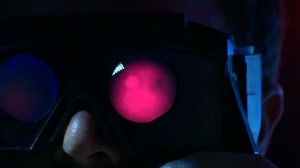
This image from TEDMED shows a closeup on an MIT student wearing an eyeMITRA prototype.
The MIT Media Lab's Camera Culture Group, led by Dr. Ramesh Raskar, has innovated the smartphone eye diagnostic space before. Their NETRA software for smartphone-enabled eye exams spun off into EyeNetra, which raised $1 million in first round funding last year. Prior to that, they developed CATRA, a cheap smartphone connected device for diagnosing cataracts.
At TEDMED, Raskar announced (and demoed) the lab's newest project, eyeMITRA. A demo of an earlier prototype, under the name RetiCue, has been online since last year. The new device isn't a snap-on camera lens like the lab's last two inventions, but instead a pair of smart glasses that displays a realtime image of the wearer's fundus.
Raskar said the technology could be useful as a cheaper, smaller diagnostic tool for early diagnosis of diabetic retinopathy, a complication of diabetes which can lead to blindness. This is the same basic use case as Welch Allyn's iExaminer system, a recently FDA-cleared smartphone-enabled fundus camera. But while Welch Allyn's device, which was also featured at TEDMED's Smartphone Physical demonstration, is only for clinical use, Raskar said eyeMITRA could also be used at home.
"Imagine you wake up in the morning, brush your teeth, take our eyeMITRA glasses, put them on." he said. With all that data, the company could "do a longitudinal and a cross-sectional analysis, and then of course create algorithms, and really get to the world of predictive analytics. The eyes are not just windows into your health, but into the heatlh of society."
Although diabetic retinopathy is the beginning, Raskar said that reliable realtime pictures of the eye open the gates for all kinds of preventative diagnoses. The eye is the only part of the body that offers noninvasive imaging access to both blood vessels and nerves. Because of this, many chronic conditions have early warning systems that can be detected via the eyes. Raskar listed AIDS, rheumatoid arthritis, hyper-cholestrolemia, tumors, Wilson's disease, and neurological conditions like Parkinson's and Alzheimer's as just a few possibilities.
With such a wide potential for noninvasive diagnosis, one wonders if Raskar and his team are considering entering the race for the Tricorder X Prize. It's certainly clear that their vision for the technology extends far beyond eye care.

















